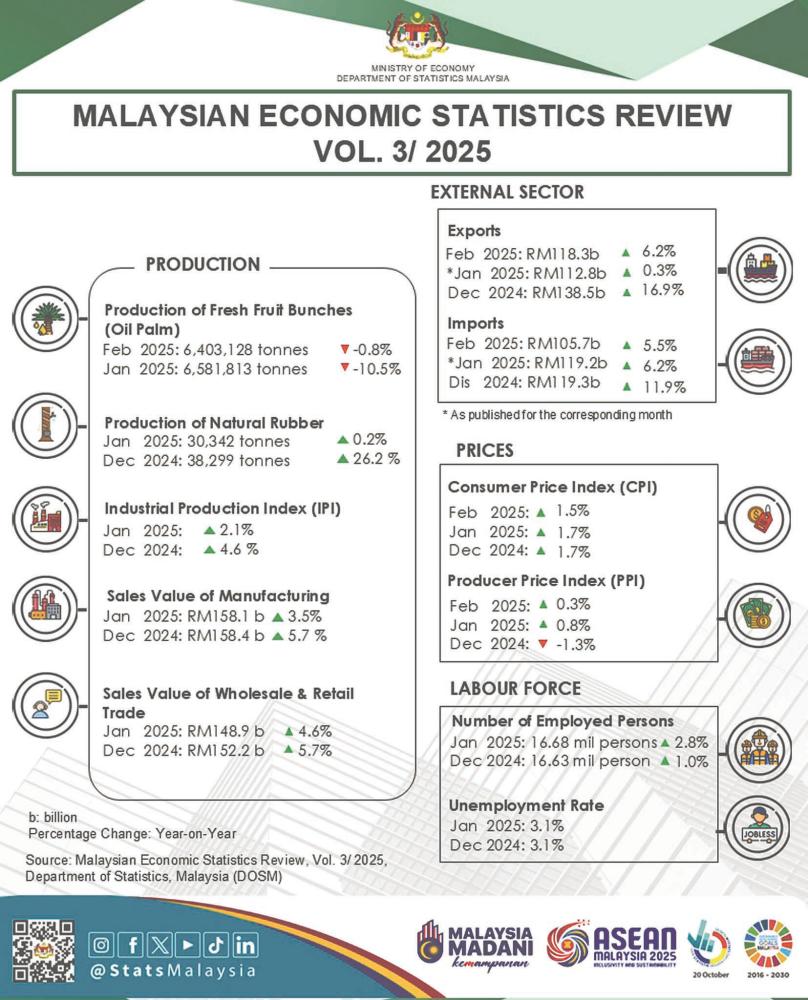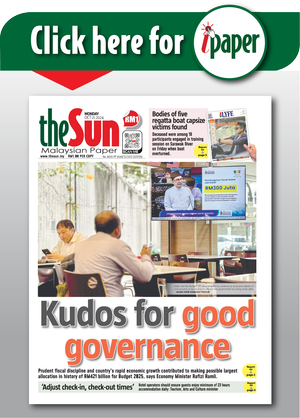PETALING JAYA: Malaysia’s economy grew by 5.1% in 2024, an improvement from 3.6% in 2023, said Chief Statistian Malaysia, Datuk Seri Dr Mohd Uzir Mahidin when highlighting Malaysia’s economic trajectory.
“All major sectors recorded growth, with the services sector leading at 5.4%. The manufacturing sector expanded by 4.2%, while construction saw a remarkable increase of 17.5%. The agriculture sector registered a growth of 3.1%, reflecting steady progress in the sector,” he said, adding that mining and quarrying posted a slower rise of 0.9%, contributing to the overall economic expansion.
Maintaining its upward trend, Malaysia’s industrial production recorded moderate growth in January 2025, with the Industrial Production Index (IPI) rising by 2.1% year-on-year.
The increase was primarily driven by the manufacturing sector, which expanded by 3.7%, though at a slower pace than the 5.8% growth recorded in December 2024. Meanwhile, the mining sector contracted by 3.1% whereas the electricity sector recorded a slight decline of 0.1%. On a month-on month basis, the overall IPI slipped by 0.4%, reflecting a slowdown in industrial activity.
Sustaining its growth trajectory, Malaysia’s manufacturing sector continued to expand, with total sales reaching RM1.9 trillion in 2024. In January 2025, the sector recorded a 3.5% increase in sales value, reaching RM158.1 billion, following a stronger growth of 5.7% in December 2024.
Leading this expansion, the food, beverages and tobacco industry recorded a notable rise of 10.6%. Similarly, the electrical and electronics sector posted solid growth, climbing 7.3%. Contributing further, non-metallic mineral products, basic metal, and fabricated metal products registered a moderate increase of 2.1%. However, on a month-on-month basis, this sector recorded a dip of 0.2% compared to December 2024.
Taking a broader perspective, Malaysia’s wholesale and retail trade sector recorded RM148.9 billion in sales in January 2025, marking a 4.6% increase compared to the same month last year. This growth was primarily driven by strong performances in retail trade, which expanded by 8.2%, and wholesale trade, which grew by 4.9%.
In tandem with this upward trend, the volume index also registered a year on-year increase of 3.8%, reflecting sustained demand in both retail and wholesale segments. However, on a month-on-month basis, total sales declined by 2.1% as compared to December 2024. This contraction was largely attributed to a significant drop in motor vehicle sales, which plummeted by 19.4%, highlighting a slowdown in consumer spending within the automotive sector.
Amid steady economic conditions, Malaysia’s inflation remained stable at 1.7% in January 2025, holding steady at the same rate recorded in December 2024.
Malaysia’s trade sector continued to expand in early 2025, supported by resilient export and import performances. In January, total trade grew by 3.1% year-on-year to RM241.9 billion, reflecting sustained demand across key industries. Export growth remained positive, rising to RM122.8 billion, a modest increase of 0.3%.
However, despite the year-on-year expansion, trade activity moderated on a month-to-month basis. Compared to December 2024, total trade declined by 6.2%, with exports edged down by 7.2% and imports contracting by 5.1%, indicating a temporary slowdown in external demand.
Pertaining to Malaysia’s labour market trends, Mohd Uzir emphasised that “Malaysia’s labour force saw an expansion in January 2025. The number of employed persons increased by 455,000, a rise of 2.8% from January 2024, bringing the total to 16.68 million.
Meanwhile, the number of unemployed persons declined by 26,100, marking a 4.7% drop to 533,800. The unemployment rate remained unchanged at 3.1% as recorded in the last month, signalling continued stability in the job market.
Mohd Uzir highlighted that Malaysia’s Leading Index (LI) signalled positive economic growth in January 2025. The index recorded a year-on-year increase of 0.4%, reaching 112.5 points, marking 14 consecutive months of expansion.
Despite the annual growth, the index registered a monthly decline of 1.2% as most components weakened. Additionally, the smoothed LI remained below 100.0 points, reflecting cautious economic prospects while global challenges continue to exert pressure on Malaysia’s economic outlook.









